Cite this document
(“China Specialty Coffee Industry Assignment Example | Topics and Well Written Essays - 3500 words”, n.d.)
Retrieved from https://studentshare.org/business/1524853-china-specialty-coffee-industry
Retrieved from https://studentshare.org/business/1524853-china-specialty-coffee-industry
(China Specialty Coffee Industry Assignment Example | Topics and Well Written Essays - 3500 Words)
https://studentshare.org/business/1524853-china-specialty-coffee-industry.
https://studentshare.org/business/1524853-china-specialty-coffee-industry.
“China Specialty Coffee Industry Assignment Example | Topics and Well Written Essays - 3500 Words”, n.d. https://studentshare.org/business/1524853-china-specialty-coffee-industry.


